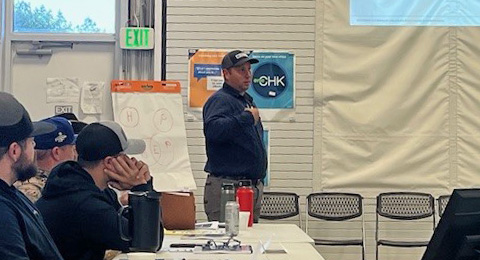Stay Accident Free Every Day
It’s our goal that every employee and contractor operates safely and returns home safe from work each day. We establish and implement strict safety standards and thoughtfully follow our Safe and Compliant Operations Policy, prioritizing the well-being of our employees, partners and neighbors.
Our safety culture is championed by our Board and executive leadership, owned by every employee and contractor, and managed by our HSER team. We also tie our safety performance (both employee and contractor) to the company’s compensation program for added accountability.
Safety Performance

Total Recordable Incident Rate (TRIR)
Lost Time Incident Rate (LTIR)
“It is our expectation that every employee and contractor returns home safe from work every day. Chesapeake’s Safe and Compliant Operations Policy applies to everyone on our worksites, establishing a culture that aims for zero injuries and zero incidents.”
–Matt Garner, Vice President – HSER

Studying Safety for Continuous Improvement
Despite a strong safety performance, 2023 was not a year without safety challenges and lessons to be learned. Through our environmental and safety management system, we identify potential risks our employees may encounter and mitigate them through planning, prevention and processes.
| Measuring | Monitoring | Compliance | |
|---|---|---|---|
| Leading Indicators |
|
|
|
| Emerging Focus Areas |
|
|
|
Safety Focus Areas and Introducing SIF
Working safely each day requires ownership from every individual working at a Chesapeake location. Based on our analysis of our 2023 safety performance, we identified the below safety focus areas for 2024.
- Reducing strikes / contact with a release of stored energy
- Reducing injuries caused by a falling object or load moving
- Increasing field verification of critical controls
- Learning from SIF potential events
- Extending SIF training to all field employees
In 2023, Chesapeake adopted SIF indicators into our safety program. By measuring and studying those events that could be life-altering, we can drive impactful improvement through targeted training and the implementation of critical controls.
Our HSER team kicked off its SIF training program in 2023, starting with our executive leaders, and followed by a series of workshops with the next level of field leaders. By being well-equipped to help identify exposures and reduce SIFs, these field leaders are now taking what they learned and facilitating the same workshops with their own teams in 2024.
Since adopting SIF, the company is pinpointing where company resources should be allocated to prevent fatal, life-altering or life-threatening injuries or illnesses. As part of integrating SIF, HSER team members analyzed three years of safety data to determine where the company has the highest exposure rates. This analysis, as confirmed by a cross-functional working group and third-party consultant, guided the company’s 2024 safety focus areas.
Improving Contractor Safety
Maintaining a safe work environment and supporting safe behaviors is a commitment that our employees and contractors own together. We hold each other accountable for keeping our sites, workforce and communities safe. To further ensure accountability, we tied contractor safety to our employee compensation metrics.
From the start of a relationship with Chesapeake, contractors must pass a qualification process including an evaluation of each potential contractor’s safety and environmental record. We use an online contractor management platform during the hiring process and for ongoing monitoring, which reviews and verifies contractor regulatory, environmental and safety-related requirements and documentation. Before approval, the prospective contractor must also agree to abide by Chesapeake’s Supplier Code of Conduct.
Once approved, Chesapeake contractors complete both an industry orientation course and a Chesapeake-specific safety orientation before they arrive at a company location. The orientation sets clear safety expectations in accordance with industry-standard safety guidelines and establishes minimum requirements for HSER practices.
Each year we review and revise this orientation to verify methodologies, comply with new regulations and identify improvements. We also regularly review our contractor safety handbook, which outlines the basic safety and environmental requirements that personnel must follow when working on our locations.
To further emphasize our commitment to safety, we host safety meetings, during which our Operations staff tailor safety discussions to the operational areas where contractors are working. We also conduct contractor assessments in the field. These assessments, coordinated with our HSER Audit team, confirm that our contractors are reporting their safety performance accurately. If a contractor’s safety program doesn’t meet our minimum standards, they receive disciplinary action that could include terminating their work with Chesapeake.

Our contractors agree to:
- Honor our core values
- Observe our Code and all HSER laws, regulations, rules and permit requirements
- Report and take immediate steps to correct all accidents, injuries, unsafe or unhealthy work conditions
- Provide a safe and healthy workplace for all employees
- Prohibit harassment, violence, weapons or drug or alcohol use on-site
- Report concerns to Chesapeake through any number of outlets, including our anonymous website
Supporting Short Service Employees
We also recognize the importance of supporting short service employees (SSE), or employees with less than six months of experience, in their initial on-the-job training and performance. Both of our field teams host mentoring programs that pair SSEs with more tenured employees. During this mentorship, SSEs receive supervision while performing daily field activities and directed training.
At our Sayre, Pennsylvania, field office, we host a training facility with a comprehensive equipment setup that enables new employees to learn about Chesapeake’s facility design, operational standards and processes from well to pipeline. The facility contains equipment an employee is likely to encounter in the field and each piece is labeled and accessible in a controlled environment.
Driver Safety
Most of our fleet drivers spend time daily behind the wheel of a motor vehicle. We work to improve motor vehicle safety through driver education and driver monitoring. Chesapeake fleet drivers participate in the SMITH Driving System Program, which offers hands-on training similar to driver’s education and defensive driving curriculum. After the training, employees begin to acquire consistent habits that help prevent accidents.
Also, each Chesapeake vehicle includes an in-vehicle monitoring system to identify employee driving habits and address safety concerns. Supervisors are provided with regular reports on driver safety an opportunity to review employee performance.
Motor Vehicle Accident Rate (per million miles)

In 2022, 90% of our preventable accidents took place at or near parked locations and occurred at low speeds. As a result, in 2023, we reapplied focus to these types of incidents by challenging all Chesapeake employees to participate in at least one of our driver safety training courses. At the end of the year, we had trained at least 98% of our workforce in driver safety resulting in a MVAR of 1.37, a 21% year-over-year improvement.
(1) Calculation methodology for this metric was revised in 2023 to better reflect accepted industry practice. Historical years shown here have been recalculated utilizing the new methodology interpretation to allow for consistent comparison.


